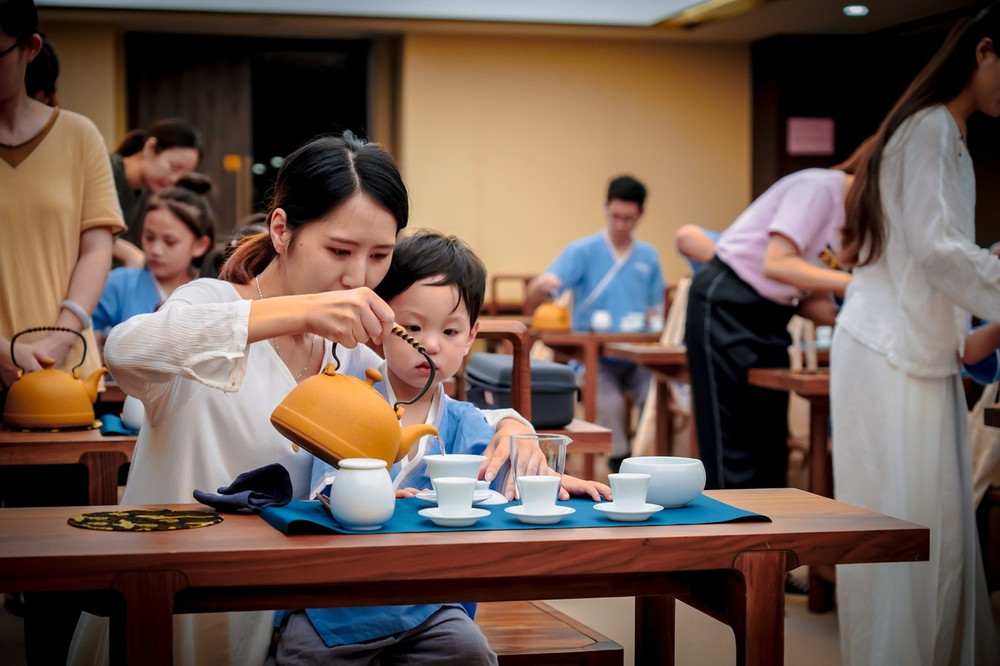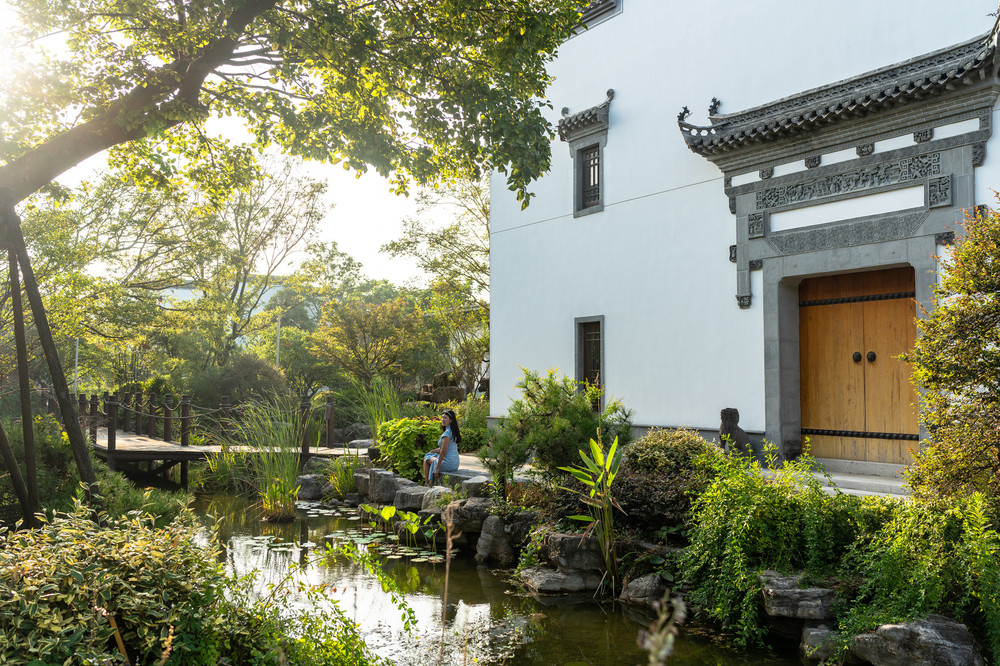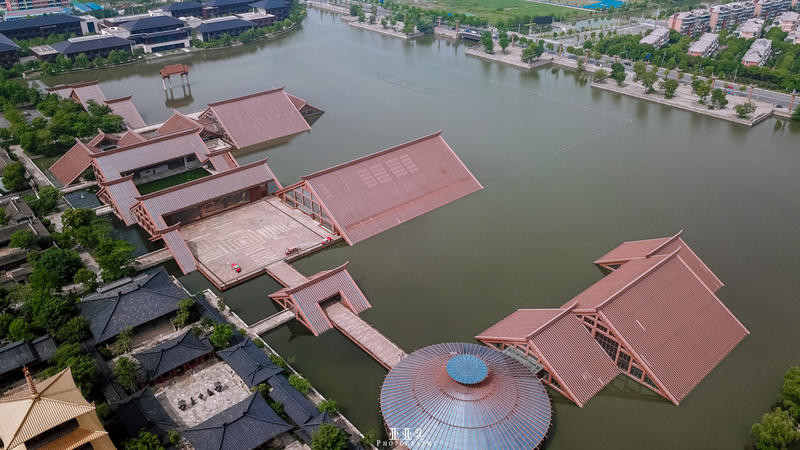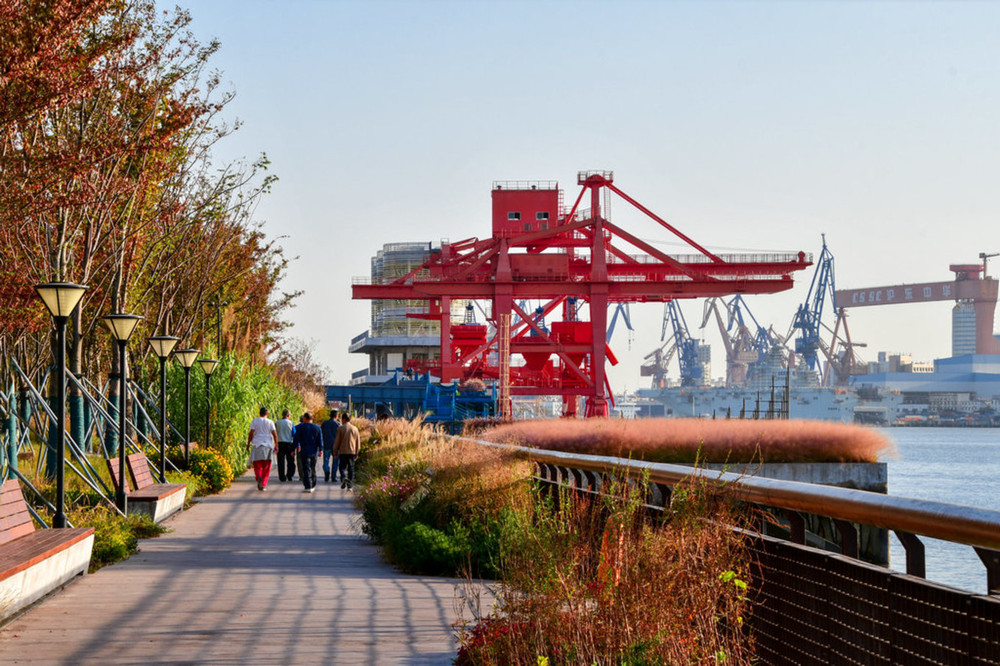**Trip to Zhujiajiao: A Day’s Journey with Friends**
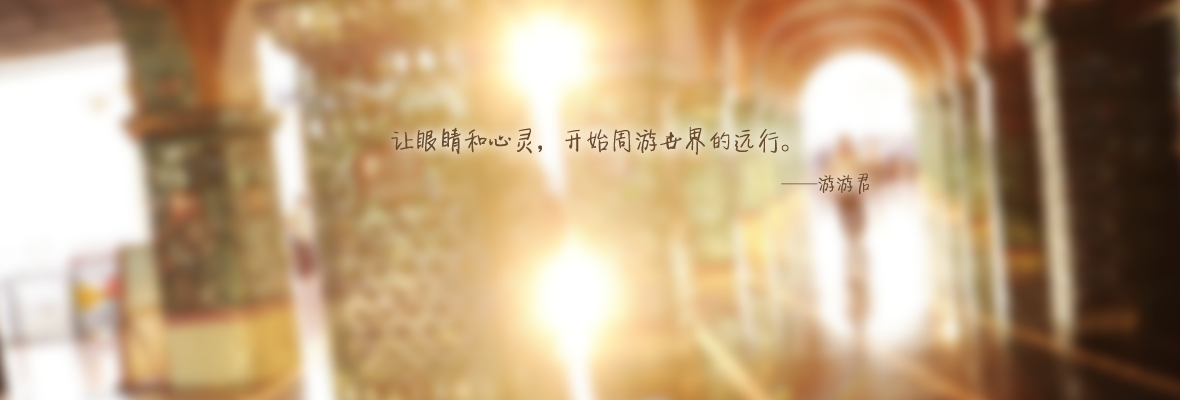
**Duration:** 1 day
**Time:** April
**Companions:** Friends
**Mode of Travel:** Free and easy
**Published on:** 2024-05-01 at 09:14
After days of drizzle, a gentle breeze played with the light shadows of the rain. It was the first day of the third lunar month in the year of Jia Chen (2024), a day of clear skies and a gentle breeze. Like the ancient town of Zhujiajiao in Qingpu, Shanghai, I fulfilled my wish to revisit an old place, a place I had not seen for nearly two decades!
The ancient town of Zhujiajiao is nestled by the Dianshan Lake, reflecting and enhancing each other’s beauty. The town is nourished by the lake, and the lake is made magical by the town. It is curious that while the lake is named after Dianshan, the mountain itself seems to have vanished. Why is that? The Qing Dynasty’s ‘Gazetteer of Qingpu County’ records: ‘Dianshan is located fifteen miles west of the county, with Xue Dian Lake… The mountain stands firm in the lake. In the past, it was compared to a falling star floating on jade.’ Although Dianshan is less than twenty meters high, it was once hailed as the ‘ancestor of the nine peaks.’ Now, with the changes in the landscape, the mountain has disappeared into the lake, leaving a vast expanse of water and a land of marshes.
Located at the northern foot of the nine peaks and by the shores of Dianshan Lake, Zhujiajiao originated in the Song and Yuan dynasties as ‘Zhu Village,’ became a town during the Wanli era of the Ming dynasty, and was also known as ‘Pearl Street Pavilion,’ ‘Pearl Stream,’ or ‘Pearl Village,’ commonly referred to as ‘Jiaoli.’ The town covers an area of over two thousand two hundred acres, shaped like a folding fan, embedded in the scenery of mountains and lakes, elegant and graceful, looking back with pride!
The calm waters of the Caogang River divide Jiaoli into two parts, north and south, ‘reflecting the clear and inverted images’ in the crisscrossing river ports, ‘sometimes petals fall, following the distant fragrance of flowing water.’ The ancient streets stretch along the river; the Ming and Qing buildings stand by the water, and the stone bridges with their ancient style are particularly numerous, more than thirty-six in total, scattered over the river, connecting both banks, and facilitating the streets and alleys.
In the ‘heaven and earth misty, a hundred flowers containing bloom,’ Jiaoli is also ‘a beautiful day with a clear sky.’ Being in the south of the Yangtze River, it naturally has fertile land and beautiful water, rich and prosperous people, and the scene of ‘small bridges, flowing water, and homes’ is everywhere. The river ports are crisscrossed and winding, gentle and graceful, with black tiles and white walls beside them, most of which open the window to see the water; the secluded alleys are attached to it, naturally containing tranquility and brightness.
Jiaoli once thrived with various industries, bustling with people coming and going, but it is no longer the prosperous scene of the past. However, the town government is well aware that tourism can generate wealth, and it does not hesitate to create waves, happy to see the capital surge, so that ‘the streets stretch, and merchants and traffickers gather,’ turning into a market, promoting prosperity and attracting people. Although the industries are not the same as in the past, it does not lose the action of ‘changing the cage and the bird,’ and from this, one can see a glimpse of Jiaoli’s ‘competitive prosperity’ at the end of the Ming and the beginning of the Qing dynasties.
Ancient bridges are an indispensable part of the scenery in ancient towns south of the Yangtze River, and Jiaoli has many ancient bridges, which are no exception. The ancient bridges are either made of stone arches, stone slabs, or constructed with bricks and wood, scattered and dotted, all showing the style of the Ming and Qing dynasties, and different in shape, with a graceful posture on the water, not only for transportation on both banks but also as a group symbol of the ancient town – clear and beautiful outside, embellishing Jiaoli with grace; thick and solid inside, showing the long history of Jiaoli.
The Fangsheng Bridge leads the way, with its five-hole continuous pier arch bridge, belonging to the ‘Lu Dian Ling Guang’ in Shanghai, and it has been more than four hundred and fifty years old, having experienced the frost and snow, ‘used to watching the autumn moon and the spring breeze.’ It is more than twenty-one Zhang long, one and a half Zhang wide, and about two Zhang high. It was made during the Longqing Dynasty of the Ming Dynasty and is now a product of the Jiaqing Dynasty of the Qing Dynasty. It has become a landmark building in the town, admired by people far and wide, and has become a ‘well belt long rainbow’ scenery because of its length like a belt and shape like a rainbow, and it has become one of the ten scenes of Jiaoli.After days of drizzle, a gentle breeze plays with the drizzle, casting a light shade. On the first day of the third lunar month of the year of Jia Chen (2024), the day is clear and bright, with a gentle and pleasant breeze. Just like the ancient town of Zhujiajiao in Qingpu, Shanghai, fulfilling the wish to revisit an old place, which has been long awaited, almost two decades have passed in a blink of an eye!
Zhujiajiao Ancient Town is adjacent to Dianshan Lake, reflecting each other’s beauty. The town is moisturized because of the lake, and the lake is wonderful because of the town. Little did we know that the lake is named after Dianshan; there should be a Dianshan nearby, why can’t we see Dianshan? During the Guangxu period of the Qing Dynasty, ‘Qingpu County Chronicles’ recorded: ‘Dianshan is located fifteen miles west of the county, Xue Dian (the old name of Dianshan Lake)… The mountain stands in the lake. People in the past compared it to a falling star floating jade’, and Dianshan is less than sixty feet high, but it was once known as the ‘ancestor of nine peaks’. Today, the mountains have changed, the mountain has disappeared into the lake, and the lake has become vast, showing a watery country.
Located on the northern foot of the nine peaks, by the side of Dianshan Lake, Zhujiajiao originated in the Song and Yuan dynasties, called Zhu Village, and became a town during the Wanli years of the Ming Dynasty, also known as Pearl Street Pavilion, Pearl Stream, or Pearl Village, and commonly known as Jiao Li. The town covers an area of more than 2,200 acres, shaped like a folding fan, embedded in the scenery of mountains and lakes, elegant and graceful, looking at itself with pride! The calm waves of the Caogang River divide Jiao Li into two parts, north and south, ‘clear reflection’ in the vertical and horizontal river ports, ‘sometimes petals fall, following the distant fragrance of flowing water’. The ancient charm stretches along the river; the Ming and Qing buildings stand by the water, and the stone bridges are especially ancient, with thirty-six in total, scattered on the river, connecting both banks, and facilitating the streets and alleys.
In the ‘smoky world, a hundred flowers containing flowers’, Jiao Li is also ‘a beautiful day across the sky, a beautiful scene opens.’ Because it belongs to the south of the Yangtze River, it is naturally fertile and beautiful, with rich people and prosperous goods, the image of ‘small bridges, flowing water, and people’s homes’ is everywhere, the river ports are crisscrossing and winding, gentle and elegant, with black tiles and white walls next to it, more than half of them can see the water when they push the window; the secluded alleys are attached to it, naturally containing elegance and brightness.
Jiao Li once prospered and was bustling, and now it is no longer the prosperous scene of the past, but the town government is well aware that tourism can make money, and it does not hesitate to push the waves, happy to see the capital turnover, resulting in ‘streets stretching, merchants and traffic’, it has become a market, and the prosperous relocation has gathered people. Although the hundred industries are different from the past, they do not lose the move of ‘changing the cage and the bird’, and from this, we can see a glimpse of the ‘prosperous competition’ in Jiao Li at the end of the Ming Dynasty and the beginning of the Qing Dynasty.
Ancient bridges are an indispensable scenery in ancient towns in the south of the Yangtze River, and Jiao Li has many ancient bridges, which is no exception. Ancient bridges are made of stone arches, stone slabs, or brick and wood, dotted with stars, showing the appearance of the Ming and Qing dynasties, and different in shape, elegant on the water, not only for transportation between the banks, but also as a group logo of the ancient town – clear and elegant outside, embellishing Jiao Li with grace; thick inside, showing the long history of Jiao Li.
The Fangsheng Bridge takes the lead in the historical scene, renowned for its five-hole continuous pier arch bridge, a spiritual light in Shanghai, standing for over four hundred and fifty years, enduring frost and snow, ‘accustomed to the autumn moon and spring breeze.’ It spans over seventy feet in length, five feet in width, and about seven feet in height, originally built during the Ming Longqing Dynasty, now a relic of the Qing Jiaqing period, and has become a landmark building, admired by both locals and visitors, and its elongated shape resembling a ribbon, arched like a rainbow, has earnedThe current Fangsheng Bridge, over two hundred years old, spans across the southeast bank and the northwest riverside of the Caogang River. It fully displays the architectural style of the late Qing Dynasty with carved flowers, eight coiled dragons engraved, and four stone lions placed, which is pleasing to the eye. A stele pavilion – Fangsheng Pavilion is built on the southeast bank of the bridge for people to rest. Stone revetments are constructed along the water’s edge, merely for the mooring of boats. Although it is a reconstructed object, the Fangsheng Bridge still maintains its grandeur and ‘its spirit is always vigorous.’ Within a stone’s throw from the Fangsheng Pavilion was once the North Street, known for its ‘three-mile-long street with a thousand shops.’ After four hundred years, the North Street, though weathered by time, still retains its charm. ‘The carved railings and jade-like buildings should still be there, only the rosy complexion has changed.’ It is more than three feet wide, lined with two-story buildings in the style of the Ming and Qing Dynasties. Merchants are on the ground floor and living quarters on the upper floor. People can chat and pass items to each other through open windows. The North Street winds along the Caogang River, running from West Meizhou Alley to East Fangsheng Bridge for over two miles. It carries a few century-old shops, alas, few and far between. The Fangsheng Bridge facilitates transportation and is naturally bustling with activity. North Street also takes advantage of the time and situation, expanding within the homes. It fully displays ‘a million fish and dragons, each dancing in their own form.’ Its ‘sliver of sky’ unique structure ensures that the street remains true to its original flavor over time. Strolling through it, one can still enjoy a sense of comfort and nostalgia! The alleys of the corner are quite simple, all following the winding of the river. Once the residences of the wealthy and powerful, they still ‘do not hide their flaws, clean but not lonely.’ Among them, the Xi’s Hall can be considered the leader. Not only because it was once the home of the Tao family, but also because the Xi family has a long and illustrious history in the Jiangnan region. The Xi’s Hall in the corner is from the Ming Jiajing period. It lies dormant in Xijia Alley, East Lake Street, in town. The Xi family originally came from Dongting East Mountain. The Xi family in the corner comes from the branch of Gongxi Yongpei.
Zeng Yangchu served as the minister of the Ministry of Rites in the Jiajing period of the Ming Dynasty. After retiring, he moved to Zhujiajiao to avoid chaos. Then he gathered craftsmen and materials and built a residence. Later, it became a prominent family in the town. It is said that ‘the descendants multiplied and all became prominent. At that time, no one could compare with them.’ The Xi family’s residence was once a large and noble family, facing north and having a total of five halls in succession. The main gate opened on Donghu Street, and the residence extended deep to Xiangning Creek, accessible by both land and water. The residence drew on the strengths of the grand mansions in Jiangnan. Naturally, the gold decorations were winding and presented a magnificent sight. And its ‘wall gate brick carvings’ are especially remarkable. The techniques are superb, which can be seen in the exquisite patterns and delicate carvings. According to legend, a relief of ‘carp jumping over the dragon gate’ on the wall of the Xi family’s residence was completely destroyed by the Taiping Army. Later, Tan Shaoguang (1835-1863), the king of慕王 of the Taiping Army, sent people to carve another one to replace it. This is also a makeshift measure. However, its brick color and carving techniques are very different from those of its contemporaries. What a pity! ‘The scenery is unbearable to look at. Wherever one gazes, there are a thousand kinds of sorrows.’ The Xi family’s halls have changed completely. Now only the front hall and two courtyards in front and back remain. They are temporarily used as the Wu Yue Cultural Center in Zhuli to display objects such as eaves tiles, tiles, and brick carvings. To be fair, among the attractions in Zhujiajiao, nothing can compare with the post box of the Qing Dynasty. On Xihu Street in Zhujiajiao, there is the post office of the Qing Dynasty. It has a history of more than 120 years. It was designed by the British Justin in the late Qing Dynasty. The post office is a two-story western-style building constructed with brick and wood. ‘If we eliminate the miscellaneous and retain the essence’, and also make use of old materials and repair them. The original elements such as doors, windowsIt is not only a post office but also a historical relic. The post box outside the door is made of copper and has a dragon cast on its body. It is vivid and lifelike. It is no less than a century-old cultural relic. And it still functions as it used to be for putting in and taking out letters. It is really astonishing! Why has the post box of the Qing Dynasty survived many disasters and remained intact and in operation until now? It is really incomprehensible!
Near noon, and my stomach is rumbling; I am unbearably hungry. So I had a meal at a restaurant by the river on North Street. After eating, I wanted to go to Xijing Street at the northern end of Zhujiajiao to visit the Kezhi Garden and Hexin Garden where the houses are close to each other. However, at the beginning of late spring, the crazy willow catkins dance with the wind. At this time, the willow catkins are ethereal and disturbing in the air. They are pleasing to the eye with their lightness and annoying with their scatteredness. Therefore, I hesitated and turned to a nearby alley. I found a tea house by the river and leisurely sipped fragrant tea, enjoying myself in “the spring is not old, the wind is gentle and the willows are slanting”, listening to “the sound of water under the boat”, and freely viewing “the light boat crossing the long river”.
Just after 2 pm, the intention to return suddenly arose. At that time, it was just like “The warm breeze does not understand how to keep the flowers, and countless pieces fall on people.” May 1, 2024.






